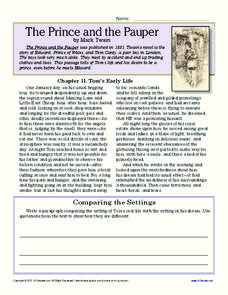K12 Reader
Indefinite Pronouns
Everyone can practice indefinite pronouns with this exercise! Learners complete 14 sentences by filling in the correct indefinite pronoun. A brief definition is provided to assist learners.
K12 Reader
Identify the Synonym
Readers are asked to select the correct synonym for the underlined words on this 10 sentence, multiple choice worksheet.
K12 Reader
Tap on the Map
Work on -ap words with a straightforward exercise. Class members read a short poem that includes plenty of -ap words and respond to three included reading comprehension questions.
K12 Reader
A Local Organization
Individuals select a local organization, research its purpose and membership, and then include these facts and details in a paragraph about the group.
K12 Reader
Write About a State
Kids select a state, describe its climate and geography, and include interesting facts about it. The template includes space for drawings and pictures.
K12 Reader
What's the Forecast?
Rain gauges, thermometers, and wind vanes. After reading a short article about weather forecasting, readers identify the tools meteorologists use to predict the weather.
K12 Reader
Who Fell into the Well?
Read this short poem to reinforce understanding of -ell words, like fell and well. Learners also respond to three reading comprehension questions, which are include right on the page.
K12 Reader
Personal Pronouns
Practice personal pronouns with a special focus on subject and object pronouns. Learners read 20 sentences and circle the subject or object pronoun in each. They note which is present with an S or an O.
K12 Reader
The Prince and the Pauper
A passage from Mark Twain's The Prince and the Pauper provides readers with a chance to demonstrate their ability to select evidence that shows the contrasts between the setting of Tom's real life and that of his dream life.
K12 Reader
He Bit the Pit
Move toward mastering the -it words with a brief exercise. Class members read a short poem that includes many -it words and then respond to three included reading comprehension questions.
K12 Reader
My Sled is Red
Celebrate the snow with a quick exercise featuring a short poem about a sled. Learners practice -ed words and answer three included reading comprehension questions.
K12 Reader
The Pot is Hot
What do a pot and a robot have in common? They both end in -ot! Kids practice their -ot words by reading the short poem included here and then tap into reading comprehension skills by answering the three questions.
K12 Reader
The Pet Gets Wet
Get those -et words down with a quick exercise. Class members read a short poem that includes quite a few -et words and then answer three reading comprehension questions.
K12 Reader
The Brown Cow in the Tower
Move toward mastery of -ow words with a quick worksheet. Learners read a poem that includes as many -ow words as possible and then respond to three included reading comprehension questions.
K12 Reader
The Rock in My Sock
No one likes that feeling of something pointy in their shoe! Explore -ock words and practice reading comprehension with this short poem and accompanying questions.
K12 Reader
The Cat on the Mat
Everyone likes a poem about a cat, especially when it includes other rhyming words that end with -at! Kids read the lines and then respond to three reading comprehension questions.
K12 Reader
Look at the Good Wood
Practice the oo digraph with a quick text and related questions. The short poem includes plenty of examples of the digraph. After reading, learners respond to the three reading comprehension questions.
K12 Reader
The Note Was in Code!
While it's quite an ode, this short poem uses the long /o/ sound repeatedly in words like code, note, alone, and phone. Kids read the selection and answer three comprehension questions about the text.
K12 Reader
Playing with Adverbs
Kids demonstrate their understanding of the different types of adverbs by using the clues provided to add a how, when, or where words to sentences.
K12 Reader
Animal Adjectives
How would you describe someone who was acting like a dog or a chicken? Teach your class the adjectives that pair with 20 different animals. They'll be able to describe anything canine or crocodilian, and everything in between.
K12 Reader
Comparative or Superlative?
Is this the easiest or hardest exercise for practicing superlatives and comparatives? Your class can find out if it's easier or harder than what they've done before by changing the underlined adjectives into comparatives or superlatives,...
K12 Reader
What’s Being Compared?
Can your pupils find the comparative or superlative adjectives in each of these sentences? To complete the exercise, individuals circle the adjectives and then note down the things being compared.
K12 Reader
Change Adjectives into Adverbs
What do you need to turn an adjective into an adverb? Sometimes you need an -ly, but there are other endings. Ask your learners to change the endings of 29 adjectives in order to transform them into adverbs and complete the provided...
K12 Reader
Adjective Antonyms
Easy or hard? Fast or slow? Invite your class members to practice with antonyms. They identify each adjective and then use provided antonyms to rewrite the sentences.























